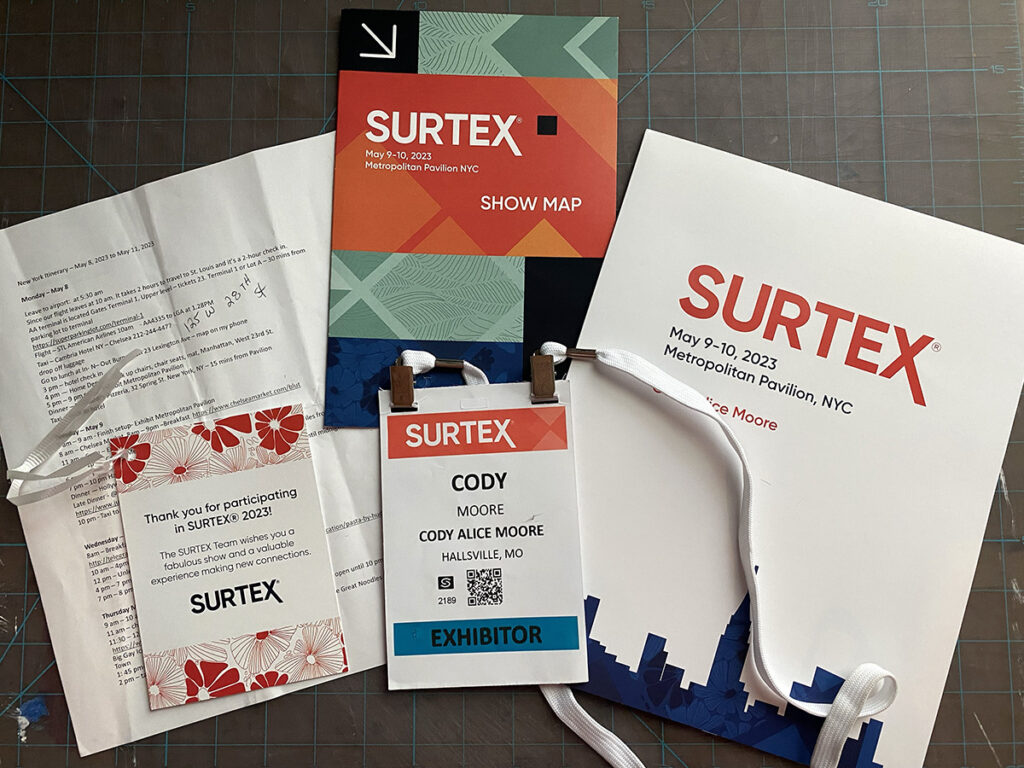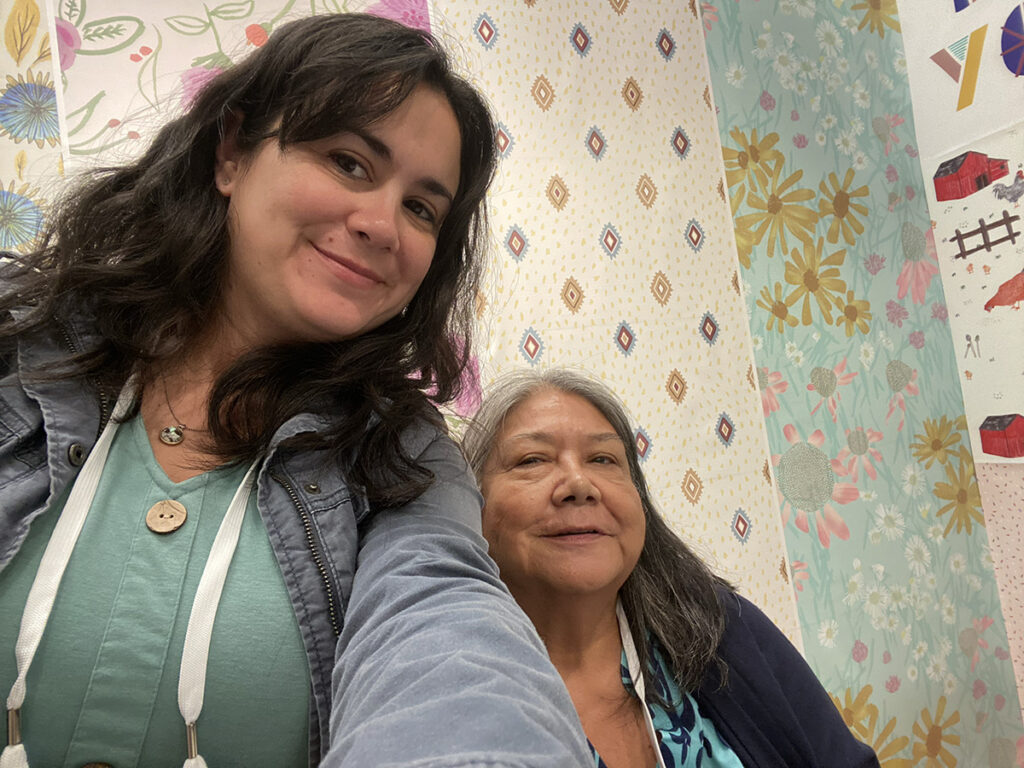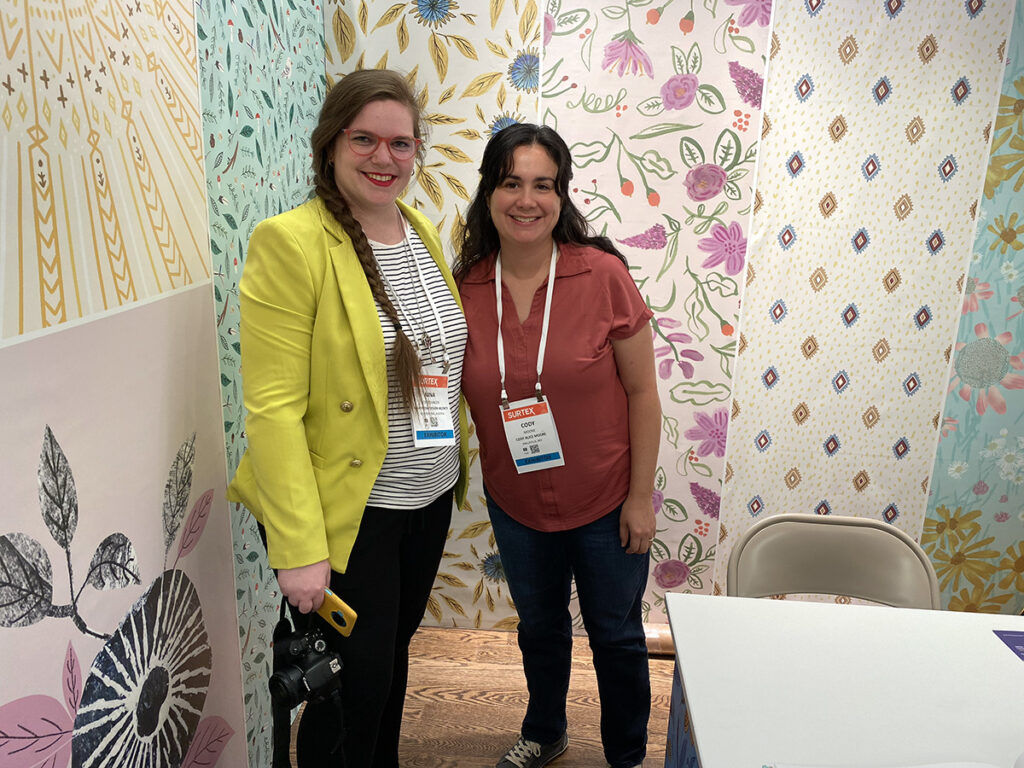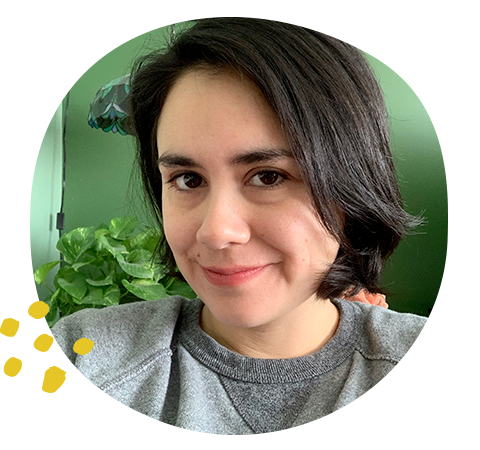“I want to be one of those artists.” That thought crossed my mind the first time I attended Surtex. The experience was exhilarating, marking my inaugural visit to New York City. At that time, I had recently taken on the role of art acquisitions for the company I worked for, bringing with me eight years of experience as a graphic designer and illustrator.
While I enjoyed working with other artists and managing a design template store in-house, stepping into the Javits Center fueled my desire to become an artist who sold and licensed their art. However, I didn’t abandon my new role as an art buyer. I held that position for over four years until a significant health diagnosis prompted me to fully embrace licensing full-time.
It took another four years until I finally had the opportunity to exhibit at Surtex. The path to get there was filled with twists, bumps, a rollercoaster of emotions, and invaluable lessons.

Attending Surtex as an Art Buyer
My first experience attending Surtex was both exhilarating and nerve-wracking, especially for someone more introverted like me. Engaging in conversations with artists and navigating from booth to booth required me to summon courage and put on my “game face.” Thankfully, I had the company of the in-house art director, who had attended the event before and was familiar with New York City.
During that initial visit, she took the lead in most conversations. I felt embarrassed for not being more extroverted, but I soon realized the valuable lessons I learned by observing her social skills. With each subsequent attendance, my confidence grew, and by the third and fourth visits, I was setting up meetings and engaging with artists independently.
Attending the show as a buyer provided invaluable insights into upcoming art trends and their potential translation onto products. One of the key takeaways was envisioning art on products — a skill I continuously honed. Buyers need to see how art can be applied to their products and ensure their commercial viability.
Another significant benefit was the networking and relationship-building opportunities that can’t be replicated through email alone. It was enjoyable to return each year and reconnect with artists I had worked with in the past, building upon existing collaborations. I developed workflows and processes for effective follow-ups after the show that proved instrumental in my current role as an artist, where pitching and networking play a vital part in success.
Feeling energized and motivated by the experiences at Surtex, I couldn’t help but envision my journey toward art licensing. The vibrant atmosphere, connections made, and creative energy surrounding the event ignited a spark within me. I realized that if I wanted to venture into art licensing myself someday, I needed to build a strong and compelling portfolio of work. Inspired by the talented artists I met and the incredible art I encountered, I embarked on a journey to seek freelance opportunities and diligently build up my portfolio. Their creativity and passion fueled my determination to take steps toward art licensing.

Changing Direction and Becoming a First-Time Exhibitor
My exit as an art buyer came suddenly with a tonic-clonic seizure. Initially, I was apprehensive about leaving my secure in-house job with its accompanying benefits. As my tenth anniversary with the company approached and preparations for another year at Surtex were underway, including booked plane tickets and ongoing work on informational booklets for potential artists — I had no immediate plans to strike out on my own.
But life had other plans for me. My seizure was caused by a brain bleed linked to a rare genetic condition prevalent in my family. It’s hard to express the extent of the turmoil I felt following my seizure and subsequent diagnosis; it felt like I was in a living nightmare. However, this challenging journey ultimately led me to recognize the importance of prioritizing my well-being, managing stress more effectively, and gaining the flexibility to shape my time and the trajectory of my art licensing career.
During my first year as a full-time freelancer, I often felt like I was barely staying afloat. Adjusting to being a productive artist working from home proved to be challenging. However, amidst the struggles, I dedicated time to creating personal artwork and an art project that served as a therapeutic outlet for processing everything I had experienced.
To further enhance my skills and knowledge, I actively participated in workshops, including being a founding member of Shannon’s Pitch Your Portfolio and Artful Pricing classes and community.
Then, the unexpected COVID-19 pandemic hit, and the world came to a standstill. Although I continued creating during this period, I noticed that whenever I pushed myself too hard or gained momentum, my body and mind would send clear signals that I was doing too much. Recognizing the need to prioritize my health and well-being, I listened to these signals.
In the fall of 2021, my doctor advised me to undergo surgery to remove one of the growing malformations identified in imaging tests. Thankfully, the surgery was successful, and a year later, when I learned that Surtex would be returning after a two-year hiatus, I was among the first to sign up. Initially, I hesitated about attending due to the financial risks involved, as Surtex is expensive. However, I reminded myself that attending Surtex has always been a goal since I first discovered the art licensing world. Despite the fears, I knew deep down that I had to seize this opportunity.
Related Articles: Shannon’s Surtex Blog Series

Overcoming Challenges and Lessons Learned
Committing to exhibiting at Surtex was an easy decision once I made up my mind. However, the real challenge lay in the preparation and planning, especially since it was my first time as an exhibitor. Unlike my previous limited experiences of exhibiting with an in-house team, I had little knowledge and had to handle numerous moving parts on my own.
To begin, I scheduled a portfolio review with an art representative. With around 85 portfolio pieces, I knew I had a good amount to show, but most of my previous work had been created in isolation. Working from home, I lacked the valuable feedback needed to enhance the commercial viability of my art. Having a second pair of eyes provide detailed feedback was invaluable. I diligently took notes and spent a significant amount of time leading up to Surtex reworking and fine-tuning my art.
The majority of challenges arose two to three months before the event. The Surtex sales contact provided exhibitors with booth renderings, which I utilized to create a mock-up of my booth design. However, the concern arose when it came to the large banners that needed to be shipped to New York.
They arrived in an eight-foot-high cardboard tube, unfortunately bearing a significant dent. It became evident that they needed to be resized. Picture unrolling an eight-foot-tall banner on your bed, with a folding table wedged next to it because it was too wide for your queen-size bed. I had to employ my largest cutting mat, along with an X-Acto knife and ruler, meticulously trimming it down to a more manageable size.
In hindsight, it would have been wiser to have the banners printed in smaller sizes, facilitating easier shipping and reducing the risk of damage. Alternatively, they could have been designed to fit effortlessly into my suitcase!

Tips and Tricks for Navigating the Surtex Experience
Now that I’ve had my first exhibition, I have some insights and things I wish I had known beforehand. Here are a few key points:
Portfolio Review
As I mentioned earlier, dedicating time to fine-tune my art was crucial. In the future, I plan to schedule regular reviews for any new work I create. This will allow me to avoid the intensive preparation I had to undertake for the show.
Shipping
I had heard from other exhibitors that they personally shipped their banners to a friend in New York or to their hotel. However, I didn’t have a friend in New York, and I felt apprehensive about giving up control. So, I decided to use the shipping and storing services provided by Surtex’s partner, Freeman. Even with this choice, I experienced anxiety and required extensive support from the representative throughout the entire process. It was also quite expensive — a lesson learned the hard way. This brings me to my thoughts on banner printing.
Banner Printing
Some exhibitors had smaller banners that didn’t cover the entire booth walls. It seemed simpler and easier for shipping and set-up. However, I believe that having all the walls filled with my art, including the outside of my counter, fascia, and booth sign, made a significant impact on potential buyers. I know from being a buyer as well that sometimes depending on how simple you go for your booth design can also come off as not as professional. If I were to do it again, I would design my booth banners to be smaller, arriving pre-cut (no more cutting on my bed, please!), and specifically designed to fit in my suitcase for easy travel. I spoke to a few exhibitors who did this, and their booths looked fantastic.
Marketing
Since I spent a significant amount of time leading up to the show refining my portfolio, I had limited time for marketing myself. However, I was pleased that I utilized the week before the show to reach out to attendees through the Surtex exhibitor portal, inviting them to visit my booth. I focused my efforts on greeting card companies and related industries. It paid off, as three of the leads who visited my booth were companies that I had messaged.
My journey from art buyer to exhibitor at Surtex has been an incredible transformation, filled with excitement and growth. Attending Surtex as an art buyer gave me valuable insights into emerging art trends and ignited my passion for art licensing. Making the leap to becoming a first-time exhibitor required me to stretch myself, but the rewards were beyond measure. I faced challenges during the preparation and planning phase, but these experiences taught me important lessons about portfolio reviews, shipping options, and optimizing booth design.
To anyone considering a similar career transition, I wholeheartedly encourage you to embrace the possibilities, seek valuable feedback, and continuously refine your craft. From being an art buyer to becoming an exhibitor at Surtex, this journey has shaped me both personally and professionally, and I am eagerly looking forward to the future of my art licensing career.

Written by Cody Alice Moore
Website: www.codyalicemoore.com
Instagram: @codyalicemoore
Class: Client Feedback Strategies for Creatives
Cody is an artist, illustrator, and surface pattern designer with over 15 years of experience. Cody discovered surface design while working for four years as an art buyer for a national photo lab. Since 2019, she has been creating art full-time for her budding portfolio and growing collection of licensed designs.